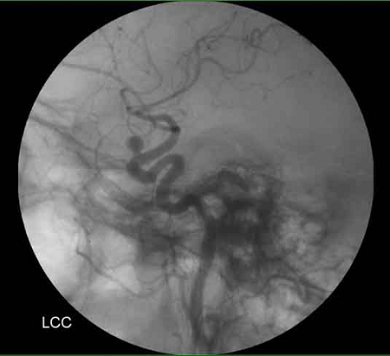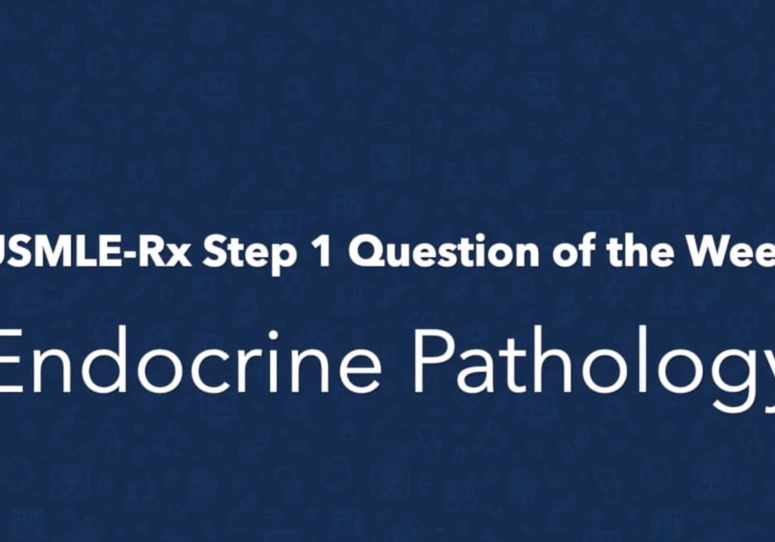Check out today’s Step 1 Qmax Question Challenge.
Know the answer? Post it below! Don’t forget to check back for an update with the correct answer and explanation (we’ll post it in the comments section below).
 A 30-year-old woman is found unconscious in her home by her husband. On arrival in the emergency department, she is noted to have thin, translucent skin over her abdomen with prominent varicose veins and many bruises on her shins. He denies any major medical problems in her past, though does report that she always seemed to “bruise really easily.” Her husband thinks the patient’s mother may have had similar problems with bruising, and also that she had “some sort of surgery” when her intestine was found to “have a hole in it.” An autopsy is performed, and an abnormality is discovered in the circle of Willis, similar to that shown in the image.
A 30-year-old woman is found unconscious in her home by her husband. On arrival in the emergency department, she is noted to have thin, translucent skin over her abdomen with prominent varicose veins and many bruises on her shins. He denies any major medical problems in her past, though does report that she always seemed to “bruise really easily.” Her husband thinks the patient’s mother may have had similar problems with bruising, and also that she had “some sort of surgery” when her intestine was found to “have a hole in it.” An autopsy is performed, and an abnormality is discovered in the circle of Willis, similar to that shown in the image.
Which of the following proteins was most likely defective in this patient?
A. Fibrillin-1
B. Keratin 14
C. Type I procollagen
D. Type III procollagen
E. Type IV collagen
———————–
Want to know the ‘bottom line?’ Purchase a USMLE-Rx Subscription and get many more features, more questions, and passages from First Aid, including images, references, and other facts relevant to this question.
This practice question is an actual question from the USMLE-Rx Step 1 test bank. For more USMLE Step 1 prep, subscribe to our Flash Facts and Step 1 Express video series. Score the best deal on all three products with a Step 1 Triple Play Bundle.




E, COL4A1 gene mutations
D
type 3 EDS
D
Type 4 (Vascular) EDS
COL3A1 mutations
I think mutation in “Type III procollagen” would be the answer, and this patient is a case of “Ehlers–Danlos syndrome” which can be transmitted by “Autosomal Dominant” pattern ( Her mom had some manifestation probably diverticulosis) and Aneurism which is seen in this angiography.
Type 3, Vascular EDs
Correction of the above .
Correct answer D : EDS vascular type follows autosomal dominant inheritance. Is caused by abnormal changes (mutations) of the gene known as collagen type III, alpha-1 (COL3A1), which is located on the long arm of chromosome 2 (2q31).
EDS type IV is caused by a mutation in COL3A1 gene which makes type III procollagen. This is characterized by weakness in blood vessels and the bowel wall, which predisposes them to rupture. ANSWER:D
Organ involvement and vascular involvement relate to type 3 collagen, which is defective in the vascular type of Ehlers-Danlos disease. So the answer would be D.
Remark: the authors of the question speak of ‘procollagen’, but the defect in Ehlers-Danlos relates to tropocollagen (and thus not procollagen) which cannot form fibrils. Problems in procollagen relate more to osteogenesis imperfecta in which triple helix formation (formation of procollagen) is deficient.
Hey very cool site!! Man .. Excellent .. Amazing .. I’ll bookmark your web site and take the feeds also?I am happy to find numerous useful information here in the post, we need work out more techniques in this regard, thanks for sharing. . . . . .